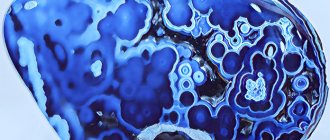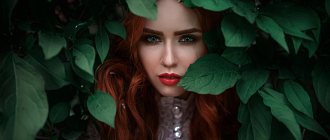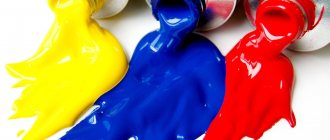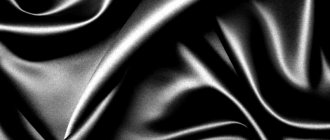Few people think that liking a certain tone can mean something. Psychology has an answer to this question; in this article we will look at what the lilac shade means.
- Lilac is a mixture of blue and red (a mixture of feminine and masculine) and signifies a bright future. Blue in this shade gives a certain chill, which also gives the meaning of nostalgia, and red - creativity. Therefore, if we speak succinctly about lilac, it means a clear future, nostalgia and creativity. A similar description is often found in teenagers who are full of energy, but at times they experience depression, and they also have a lot ahead of them.
- Also, lilac, as the results of various studies have shown, improves a person’s self-esteem. Therefore, people with a low indicator are recommended to wear lilac tones or jewelry.
If a woman likes lilac, it means that she has a creative inclination or the ability to fantasize and imagine well. It is also generally accepted that such girls like to cheat themselves, while experiencing severe stress and depression. On the other hand, such representatives of the fair sex are cautious and have a desire for harmony and aesthetics.
Usually, loving one color leads to a matching color wardrobe. But it is worth remembering that everything is good in moderation, you should not overdo it, since an excess of this shade can cause disgust from the people around you.
Symbolism
A light shade, like purple, is obtained by mixing blue and red tones. Previously, this paint was rarely found in wardrobe or interior items due to the difficulty of obtaining it, therefore it was considered expensive and prestigious.
It belongs to the cold range, although due to its proximity to pink it is much softer and warmer than blue or cyan. Traditionally symbolizes:
- mystery;
- imagination;
- creation;
- depth;
- sensitivity;
- romance;
- vanity;
- wariness.
The lilac color gets its name from the lilac, widespread in Russia. Classic purple is darker and deeper than lilac, so the properties of the first are reflected in the second in a somewhat softened form.
Red and blue symbolize the feminine and masculine, respectively. Therefore, mixing them allows you to create a comfortable atmosphere for both sexes.
Additionally, light purple represents:
- Borderline state. They are often used in meditative practices.
- Knowledge. Their presence promotes creativity, inspiration, reflection and mental development.
- In some cultures it is considered a symbol of mourning.
- The frequent appearance of color in dreams predicts global changes in the near future.
- Stealth. Lovers of purple are in no hurry to show off their inner world.
Even Medieval philosophers associated the described color with the concept of “Coincidentia oppositorum,” that is, the fusion of opposites.
In nature, violet-blue shades are due to the presence of special substances - anthocyanins. Color standards in the plant world are:
- violet;
- lavender;
- lilac;
- fuchsia.
In the language of floristry, lilac is considered a symbol of affection, reconciliation, and fidelity. Florists also claim that the more saturated this shade is in a bouquet, the stronger the feelings are expressed in it. This is also an example of luxury, aristocracy, and wealth, so you can present such a flower arrangement not only to your beloved girlfriend or friend, but also to a business partner, colleague, or respected person. In addition, soft lilac inflorescences look unusual, charm, and give positive emotions and a spring mood.
Role in psychology
In psychological science, there is a section of color perception, whose specialists study the influence of various shades on the human psyche. Scientists talk about the inconsistency of light purple tones: they often awaken opposing emotions and thoughts in a person. For example, unfocused excitement and elation, and in parallel with them anxiety, a feeling of the presence of the mystical.
The lighter the lilac, the more positive, light, pleasant feelings it evokes (up to some euphoria, serenity, relaxation).
And, conversely, the darkest variations of purple are associated with gloomy experiences and fear of the unknown. For this, followers of esoteric teachings love him.
The fusion of warm red and cold blue contributed to the emergence of a certain contradiction and conflict in lilac, so people who are at a crossroads in transitional moments in life often lean toward this shade.
How color characterizes personality
It is believed that the depth and mysticism of the lilac range is close to those who have a bright personality. However, these are not crazy optimists, but, on the contrary, creative introverts surrounded by a mysterious aura. These are definitely not gray mice, but temperamental individuals, not without a bit of snobbery. They combine all the characteristics inherent in lovers of red, blue, pink and white.
Psychologist Daria Milai
Make an appointment
The contradiction lies in the fact that such individuals simultaneously want to stand out from the crowd, demonstrate their uniqueness, and at the same time prefer immersion in the inner world, abstracting as much as possible from the external.
Does it affect health?
All the space around us influences our mental state in one way or another. When seeing lilac-violet objects, the subconscious tries to divide their color into blue and red. Thus, the nervous system is excited.
The color lilac is associated with the sahasrara chakra, thanks to which a person receives energy and knowledge of the Universe. It is located in the area of the crown and is responsible for spiritual development and insight.
Purple also helps:
- if necessary, calm down, reduce anxiety, eliminate a panic attack;
- reduce blood pressure;
- with low self-esteem;
- establish a connection with the subconscious;
- with impaired vision;
- establish contact with deep desires, feelings, needs;
- strengthen intuition;
- in the presence of astheno-neurotic syndrome;
- increase attentiveness;
- relax and fall asleep;
- reduce the symptoms of vegetative-vascular dystonia;
- in esotericism - to provide protection to a pregnant woman and her unborn baby.
What does shade mean in clothing?
Lilac predominates in the wardrobe of those who constantly strive for the ideal. These are people with their own firm position, independent of the opinions of others. They are prone to hobbies of mysticism and esotericism.
Also, purple lovers prefer privacy to a noisy crowd. They are attached to home and have a hard time being separated from loved ones. These are talented, sensitive, subtle creative people who are prone to melancholy. They are in constant search of themselves and their place, which is why they often experience anxiety and restlessness.
Face-to-face consultation
What are the features and advantages of face-to-face consultation?
Find out more
Skype consultation
What are the features and benefits of Skype consultations?
Find out more
The nobility of this color range is best manifested in velvet (if we are talking about a dark, rich tone) and silk textures. When choosing clothes, you should always rely on your inner state at the moment.
A person who prefers purple color in his wardrobe, in the eyes of others, looks like:
- extraordinary personality;
- reasonable;
- aware of his own uniqueness;
- creative, creative;
- closed and deep;
- one who is accustomed to following the dictates of his heart;
- easily suggestible, susceptible to influence;
- having a developed sense of empathy, empathetic;
- balanced and stress-resistant.
If you want to attract attention and at the same time retain a bit of mystery, to emphasize your desire to comprehend wisdom, it is undoubtedly worth replenishing your closet with lilac things.
Meaning in the interior
Purple can evoke sadness, nostalgia, and immersion in thought, so I do not recommend using this color scheme in the design of rooms where a person spends a lot of time. Suitable locations would be:
- corridor;
- hallway;
- toilet;
- vestibule;
- balcony;
- creative zone.
However, the presence of this tone must be minimized by diluting it with other suitable mysterious colors. It goes well with white, gold, orange and yellow.
The pale lilac color of the walls in the room helps to distract from unpleasant thoughts and get rid of stress. Bed linen of any shade of purple promotes deep sleep and easy awakening.
Purpose of use in advertising
Lilac is most often combined with pink. Such a gentle duet is actively used to promote “girly” products: cosmetics, perfume. It is also often featured in advertising campaigns for art products.
Purpose of use in advertising
Lilac color is very often combined with pink .
This delicate combination is actively used in the manufacture of goods for girls, so for several decades it has been firmly associated with the female gender.
However, this does not mean that lilac is suitable exclusively for girls . Colors are not associated with gender, and people attribute a connection to gender to them.
If the development of mankind had followed some other path, pink and lilac could well have become “masculine” colors.
It is also used in advertising products for women - perfume, cosmetics, care products - and their packaging is often painted in this shade.
To attract a creative audience and emphasize the elegance of the shade, manufacturers make unusual containers for these products.
The most successful materials for lilac are glass and crystal. If you paint them in this shade, it will give them depth and tenderness .
The lilac color, along with violet, is often used in advertising products for creative people, since it can adequately complement even the most shocking marketing ideas.
This choice is partly due to the fact that many creative people love purple and its various shades.
How does it affect a person?
- Has a pleasant calming effect.
- Promotes a surge of inspiration, activation of imagination and creativity.
- Improves mood and evens out the overall emotional background.
- Enhances sensuality and awakens libido.
- Reduces appetite.
- Has a beneficial effect on vision.
- Improves concentration and memory.
- Evokes deep memories.
- Allows you to relax, get rid of tension and stress.
- Has a beneficial effect on rest and sleep.
- Eliminates discomfort.
- Opens up new ways to solve a problem.
- Restores mental balance.
It is important to understand which tone predominates in a particular shade of purple: cold or warm. The degree of expression of red or blue directly affects the properties of the color scheme. On the one hand, he has energy and passion, on the other – coldness and calmness. Often, lovers of this color are in conflict with their desires.
Lilac is cunning. Watching him for a long time, you can plunge into melancholy and apathy.
The effect of violet on health
It is also interesting to learn about how lilac affects the psyche and overall well-being:
- acts as an analogue of a sedative! Makes a person more stable emotionally, reduces aggression and temper;
- can relieve panic attacks, increased anxiety and restlessness. But only in moderate quantities – in large “doses” it will have the exact opposite effect!
- normalizes cardiac activity;
- has an analgesic effect - by calming the nervous system;
- reduces blood pressure and reduces appetite;
- during meditation – promotes faster healing of wounds, activates self-healing;
- improves brain activity, increases concentration;
- It is believed that the influence of light lilac tones is much more beneficial for the psyche than dark ones.
We can conclude that lilac is an attractive, mystical color, filled with powerful energy, developing imagination and impressionability. It is preferred by extraordinary, deeply creative and freedom-loving people.
If you like the color lilac: what does it mean?
Personality formation takes place surrounded by colors. The emergence of various associations, mental characteristics and temperament influence the development of certain color preferences. This is what love for purple indicates:
- Creativity, the desire to create. Such people are interested in art. They immerse themselves in their hobbies, abstracting themselves from the outside world. These are creators and researchers.
- Rich fantasy. Lovers of purple are true generators of ideas. They willingly dream and plunge into serious, deep thoughts.
- Closedness. It is difficult for others to attract attention and arouse interest among those who prefer purple shades, since most of them are introverts. They are tired of a long stay in the company, they are wary of friendship and keep close only those who have been tested by time.
- High degree of sensitivity. Such individuals are easy to hook and offend, they have a hard time experiencing stressful situations, and often suffer from low self-esteem and inferiority complexes.
- Highly developed empathy. People who prefer a solitary lifestyle are well aware of the emotional state of others, know how to sympathize and are always open to requests for help.
- Eccentricity. This trait is especially noticeable at a young age, when a person strives to find his place in society and is on the path to developing a value system.
- Happiness comes from touching beauty. Lovers of lilac surround themselves with attractive things, they have delicate taste, and take care of their appearance.
I distinguish three main shades of lilac based on the predominance of cold and warm tones:
- Violet with a dominance of blue is loved by powerful people who find it difficult to get along in a team.
- The prevalence of red is preferred by romantic, sentimental individuals; light purple with a medium combination of heat and cold is chosen by trusting natures who are strongly attached to places and others.
Special signs
If a person gives his preference to the lilac color, this means that he has the following character traits:
- Careful attitude towards objects with which both pleasant and not so pleasant memories are associated. Such people need both positive and negative emotions. But they cannot always strike the right balance. Therefore, frequent and abrupt transitions from one emotional state to another among lilac personalities are a completely normal phenomenon;
- Incredibly gullible. Deprived by nature of such qualities as opportunism and resourcefulness, such people naively believe that they live in a world where the main criterion is “do no harm.” Thanks to their gullibility, they often fall into traps “carefully” set by people more adapted to life in this difficult world;
- Prone to low self-esteem. Lavenders are not accustomed to blaming others for their failures, because they are convinced that it is primarily their fault;
- 100% altruists and perfectionists. They are convinced that there is no limit to perfection, therefore they cannot afford to perform equally similar types of work;
- They are very attentive to their appearance. Even if they are not in the best mood, they will look well-groomed;
- The material side does not interest them, for them the creative part is a priority;
- They are flighty, therefore they diligently avoid work that is monotonous and requires a lot of time to complete;
- Demanding not only of themselves, but also of others;
- Despite their openness, they are often unrestrained in a dispute;
- Such people are indispensable for family life if you are looking for a companion who will bring not only coffee to your bed, but also happiness. Their wild imagination knows no bounds. But be prepared for the fact that your lilac companion will turn out to be useless as a provider for the family.
Of course, all of the above qualities cannot be applied to all unconditional lovers of the lilac color and its shades. Psychology is a subtle science, but as progress shows, it is very effective in influencing a person when used skillfully. Advertising, design, food and clothing industries - and this is not a complete list, where they are seriously interested in how this or that color can influence the human subconscious.
What does dislike for the color lilac mean?
A pronounced dislike for shades of purple also says a lot about character and other personality traits:
- Practicality, confidence. Such people do not like to have their head in the clouds, but prefer to work and achieve specific, tangible results. They live for today.
- Restraint. Emotionality is considered more of a disadvantage than a virtue. Because of this, it is not easy for such individuals to understand and accept the feelings of others. In everything they are accustomed to being guided by logic and reason, and not by sensations and experiences.
- Purposefulness, perseverance. The more effort, the greater the result. This is the motto of those who do not consider themselves admirers of the color lilac.
Fashionable looks with lilac color
By giving preference to the color lilac in clothes, an atmosphere of fun and celebration is created, and you can easily look impressive and stylish. The combination of colors, both delicate and bright, fits well into lilac evening dresses, decorated with sequins, rhinestones, embroidery and other decorative elements.
It is important to take into account that violet-colored clothes should look discreet, without a copious amount of decorations that distract attention to small things.
If you haven’t fully imagined how the color lilac can fit into your personal style, then we suggest you get inspired by a selection of photos of the color lilac in your wardrobe and find your own individual look.
Don't be afraid to experiment and create your own bright image. Feel free to combine purple in different clothes, and then your outfits will always attract admiring glances!
Who is it suitable for?
If we talk about external characteristics, lilac is closest to the “spring” color type. It perfectly complements the yellowish tone of the skin and hair of “spring” people. Purple combines the sensuality of red and the calmness and depth of blue, which gives rise to that very contradiction. Not every girl can afford this color in her wardrobe:
- Stylists advise dark brunettes to wear clothes in rich shades of lilac;
- tanned blondes should take a closer look at dark purple or things;
- women with pale skin and dark hair need to choose cool tones;
- Redheads should limit themselves to a few accessories of this color scheme.
Shades of lavender color
Lavender shades range from very light to medium desaturated, without crossing the line into dark. The pink undertone is closer to lilac than purple. The brightest tone is in the medium-light spectrum. Consider tones that fit this description in the Pantone system for textiles.
Psychology of purple: what it means for women
Ladies often choose light-colored wardrobe items to attract additional attention from the opposite sex. Men really see in such individuals an attractive mystery, mystery along with passion and sensuality.
Ask a question
Girls who prefer lilac shades are quite emotional, although they know how to remain calm in appearance. They are equally susceptible to anxiety and transition to a state of rest. Sensitive, vulnerable, with a fine mental organization, they want to find emotional balance.
If this description suits you, be sure to schedule a consultation with me. There you will be able to feel your integrity, depth, and find the path to harmony with the world around you and yourself.
Combination of lavender colors in palettes
Lavender salt
The relaxing effect of this plant can be converted into a picture. You see purple-lilac salt, lavender flowers, pieces of homemade soap. Lavender paints next to soft beige - wooden dishes - enhance the impression of the purple range for the set with an echo of additional contrast. The composition consists of light beige, light brown, lavender, cyclomene, violet.
Japanese lantern
During the cherry blossom season, Japanese lanterns are hung on trees to achieve a magical feeling of a fairy tale; they are immersed in a sea of colors: warm, cold colors, to feel the completeness of the world. The warm light at dusk plays with many lilac, lavender, amethyst, and violet reflections. The palette includes white-peach, sunset pink, hot pink, lavender, blue-lilac, black.
Lavender field
One of the most profound lavender experiences is a field of industrial cultivation. Like purple, the color combines lusciously with many tones and the most common pair for it is blue. It deepens the lavender and emphasizes its pink, delicate undertone. The color scheme includes pale sunny yellow, muted turquoise, sea wave, gray-purple, taupe.
Dry bouquet
In this case, it is a dry bouquet with a sachet function, which makes it not only attractive, but also functional. Rough fabric, dry painted flowers act as a soft natural contrast, and a rich lavender background and light green ribbon make the composition brighter and more attractive. It can be divided into shades such as light gray-beige, light green, gray-blue, dark blue, black.
Negative characteristics in psychology
Love for the color purple also reflects some negative character traits:
- windiness;
- illogicality;
- demandingness;
- infantilism;
- snobbery.
An excess of this color can cause depression, fatigue, and exacerbate fears and anxiety. Therefore, in the interior it is better to choose shades of purple as accent shades rather than as the main background shades. It is advisable to dilute them with black, white, gold or brown.
Lilac in the interior
- This universal color goes harmoniously with any shade from the rainbow palette. Warm, sparkling, noble, capable of giving the interior both a feeling of business and complete relaxation and carefree. It is appropriate everywhere, from the hallway to the design of guest rooms.
- You can advantageously emphasize and visually expand small living spaces using light lilac color. But this does not mean that all the walls should turn lavender in an instant!
- Lilac is the king of accents. If you want to highlight a certain wall in the room or a detail in the interior, then go for it.
- Remember that overload with this shade can have the opposite effect on the psyche. An interior that oversaturates this basic shade looks gloomy and depressing. Therefore, create wisely.
- It is well suited for the kitchen, where it is nice to chat over a cup of aromatic tea. Teenage children may also be interested in this shade. Bedrooms of this shade in combination with white will never seem boring.
When choosing lavender, don't be afraid to experiment. If you chose it, it’s not without reason. Thus, your subconscious makes you understand that creativity is not an “empty phrase” for you and you just have to try and you will definitely succeed!
Psychological effects of purple
The color violet takes you away from the world of everyday problems and puts you in a philosophical mood. It is not for nothing that this shade is so often used in the design of their temples and religious objects by both representatives of traditional religions and modern esotericists. This shade helps to establish contact with the subconscious. Under the influence of a violet person, they begin to experience insights more often. He learns to listen more deeply to himself. If you look at a purple candle before going to bed or put a purple stone (for example, amethyst) under your pillow, you can see prophetic dreams. This shade enhances intuition and makes you pay attention to details hidden from most human eyes.
The color purple enhances suggestibility. A hypnologist, a specialist in inducing hypnosis, often uses objects of this color to quickly induce trance in his patients. This property of violet can also be used by various charlatans. An excess of this color makes you sleepy and lulls your vigilance. This color is also known for its ability to positively influence human memory. He awakens the earliest, repressed memories, which are difficult to get to the bottom of without his help.











